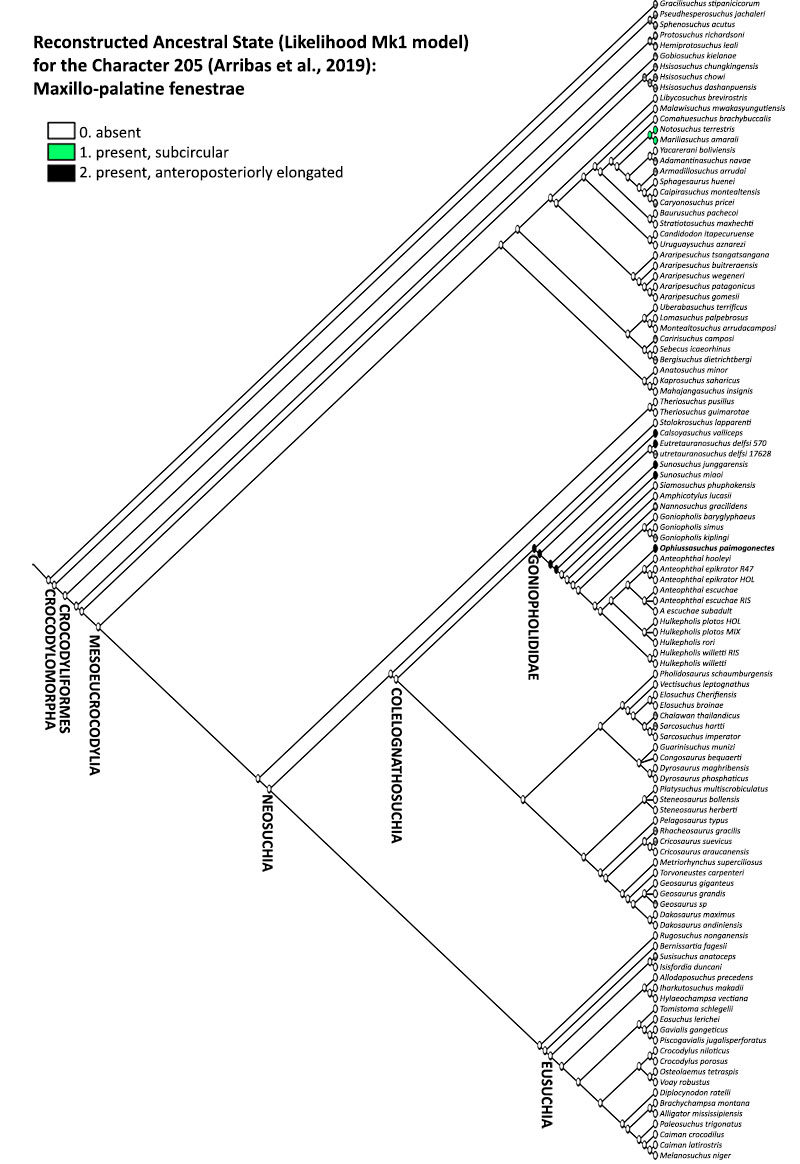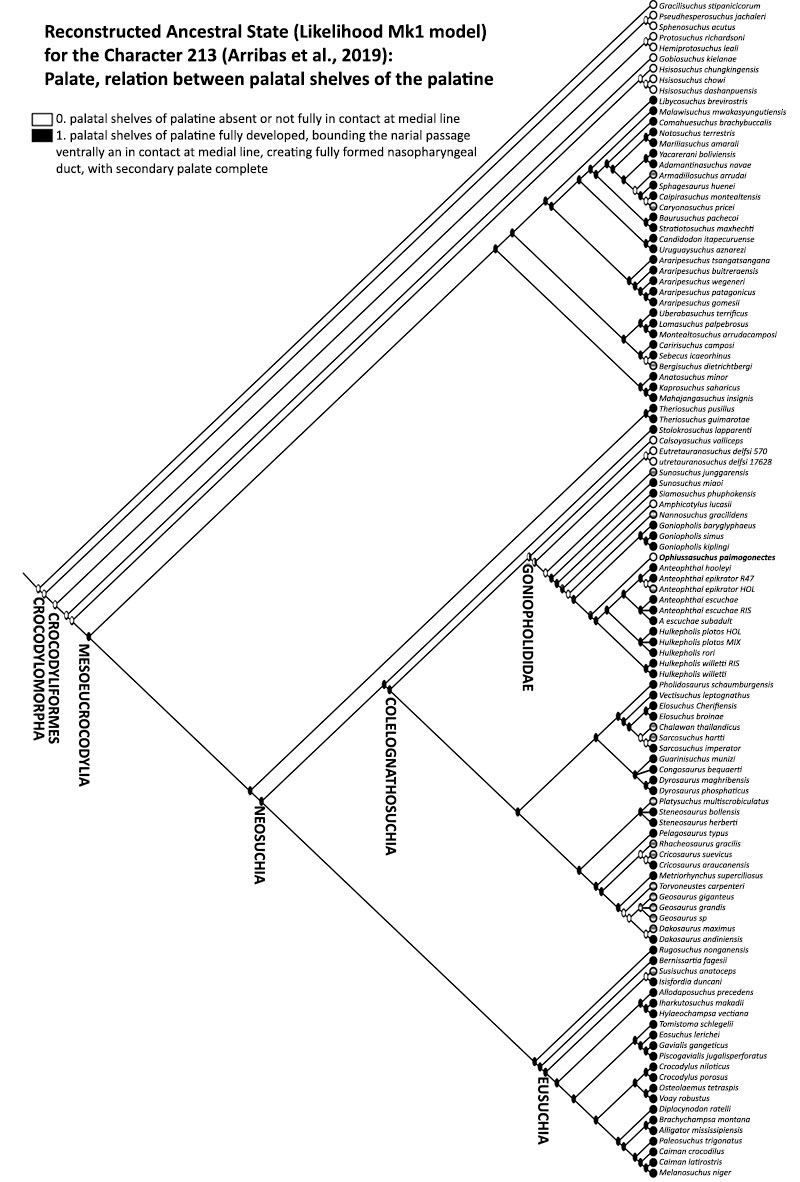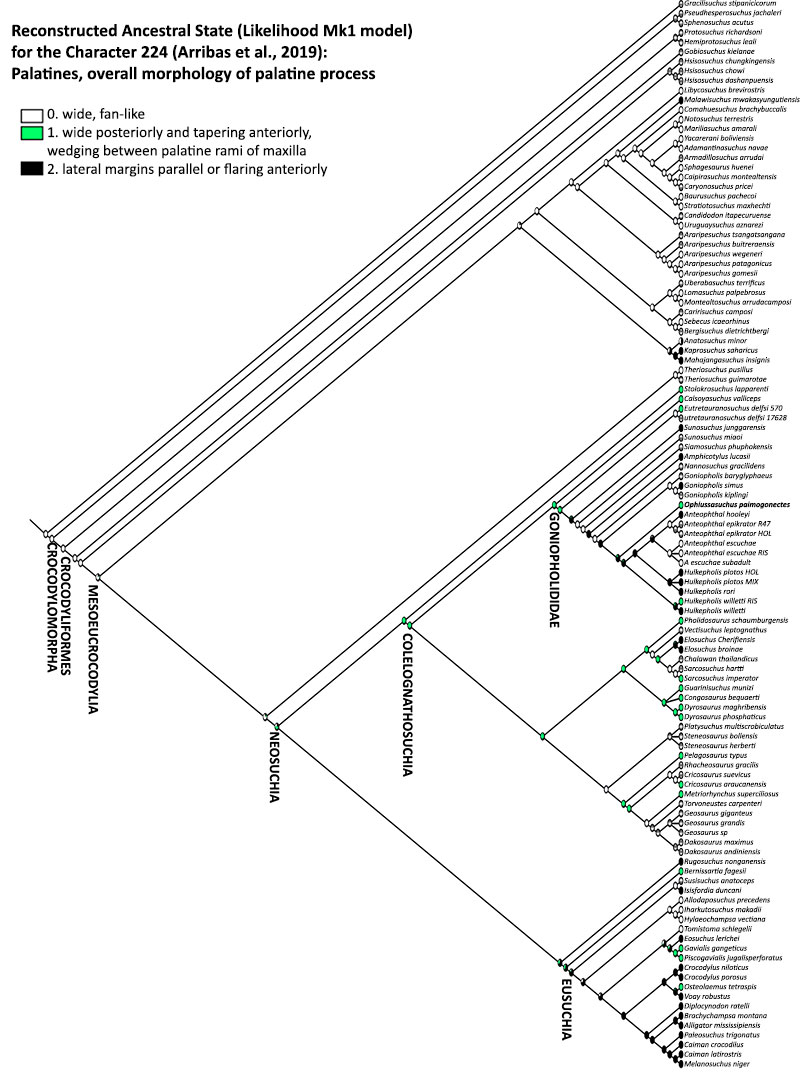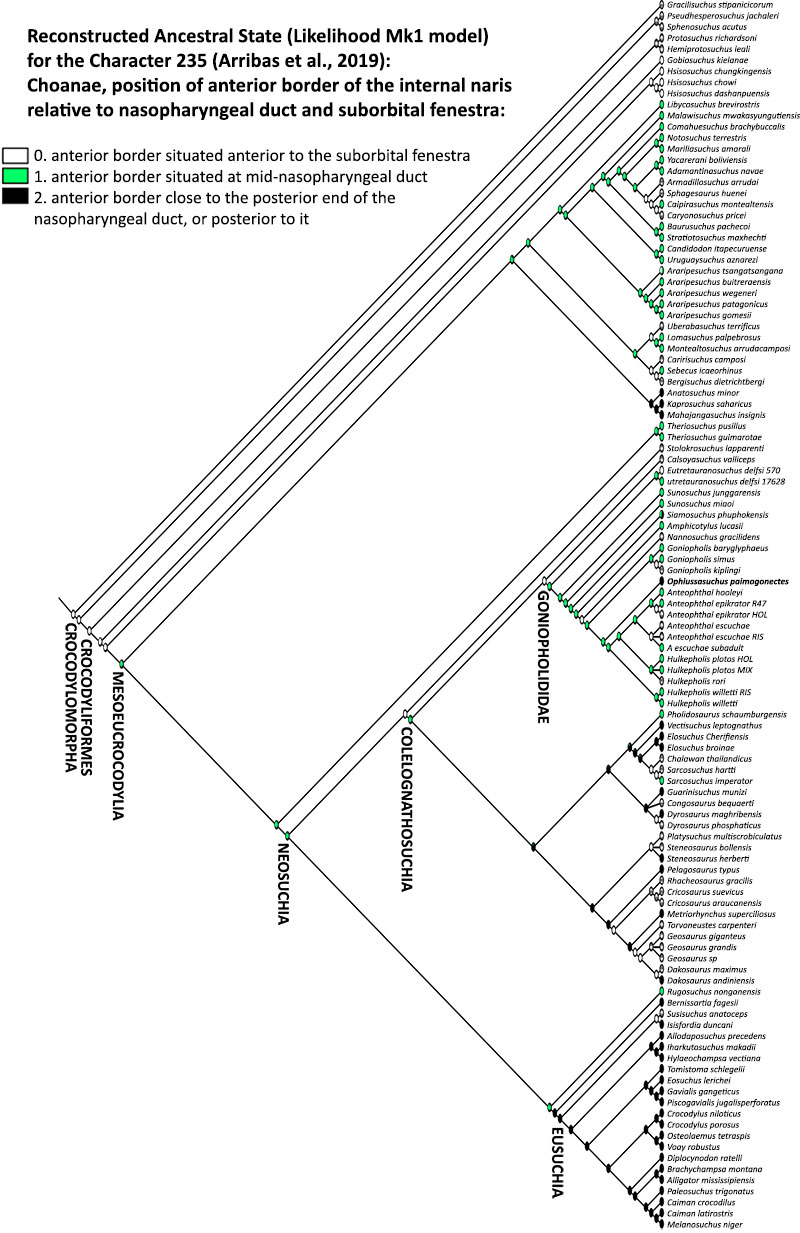APPENDIX 1
TABLE S1. Dimensions and measurements of the holotype skull of Ophiussasuchus paimogonensis gen. et sp. nov. p = preserved; e = estimated.
| Measurements of the skull | cm |
| 1. Skull, maximum length (from anterior end of premaxilla to quadrate condyle). | 37.94 |
| 2. Skull, medial length (from anterior end of premaxilla to parietal). | ~ 29.2 |
| 3. Skull, maximum medial length (from anterior end of premaxilla to supraoccipital). | ? |
| 4. Skull, length of the skull table (along the dorsal midline). | 34.97 |
| 5. Skull, width of the skull table (between posterior end of the squamosals). | 7.63 // (e)15.26 |
| 6. Skull, width of the skull table (between anterior margin of the supratemporal fenestrae). | 11.19 |
| 7. Skull, maximum width (between quadrate condyles). | (e)13.49x2 = 27.98 |
| 8. Skull, minimum width (at the level of preserved premaxillary tooth). | 3.15 (middle) / 6.3 (total) |
| 9. Skull, width at the level of postorbital bar. | 13.53 |
| 10. Snout, maximum width (at the level of the anterior end of the orbits). | 5.49 |
| 11. Snout, minimum width (at the level of the premaxillary-maxillary suture). | 3.3 (middle) / 6.6 (total) |
| 12. Snout, length (from anterior end of premaxilla to the anterior level of the orbits). | 19.64 |
| 13. Interorbital, minimum width (in the frontal). | (e)7.41 |
| 14. Frontal, width of the anterior process at the anterior margin of the orbits. | 2.33 |
| 15. Supratemporal fenestra, anteroposterior length. | ~ 3.99 |
| 16. Supratemporal fenestra, lateromedial width. | 3.6 |
| 17. Infratemporal fenestra, anteroposterior length. | 4.97 |
| 18. Infratemporal fenestra, lateromedial width. | 2.98 |
| 19. Parietal, minimum interfenestral width. | 1.1 // (e)2.2 |
| 20. Frontal, total length. | 10.7 |
| 21. Naris, length. | .06 |
| 22. Naris, width. | 1.27 |
| 23. Quadrate, average width. | 3.92 |
| 24. Pterygoid, width between the distal flank. | 9.15 |
| 25. Pterygoid, length in the lateral flank. | 7.97 |
| 26. Choana, length. | 7.89 |
| 27. Choana, width. | 0.53 |
| 28. Orbit, length. | 4.49 |
| 29. Orbit, width. | 3.69 |
| 30. Suborbital fenestra, anteroposterior length. | 9.98 |
| 31. Suborbital fenestra, maximum transverse width. | 5.25 |
| 32. Jugal, maximum length. | 13.98 |
| 33. Orbital ramus of the Jugal, thick in the middle. | 3.05 |
| 34. Orbital ramus of the Jugal, length (up to postorbital bar). | 6.91 |
| 35. Jugal, infratemporal bar length (from postorbital bar). | 5.98 |
| 36. Jugal, average thickness of infratemporal bar. | 1.2 |
| 37. Jugal, average width of infratemporal bar. | 1.41 |
| 38. Postorbital bar, maximum anteroposterior diameter. | 2 |
| 39. Postorbital bar, minimum anteroposterior diameter. | 1.03 |
| 40. Foramen magnum, maximum transverse width. | ? |
| 41. Foramen magnum, maximum dorsoventral thickness. | ? |
| 42. Premaxilla, maximum width. | 3.96+3.75 (mid) / 7.5 (tot) |
| 43. Postsnout length to the supraoccipital. | ~ 9.71 |
| 44. Postsnout length to the quadrate condyle. | ~17.26 |
| 45. Width between the fifth maxillary teeth. | 6.03 / (p)11.04 / (e)12.06 |
| 46. Number of maxillary alveoli. | 18 |
| 47. Number of premaxillary alveoli. | 5 |
TABLE S2. Ratios of the holotype skull of Ophiussasuchus paimogonensis gen. et sp. nov.
| Ratios of the skull | % | |
| 1. Snout length/Medial Skull length | 19.64/29.2 | 0.6726 |
| 2. Snout length/Maximum medial Skull length | 19.64/? | ? |
| 3. Snout, minimum width/Snout, maximum width | 3.3/5.49 | 0.60109 |
| 4. Snout, minimum width/Snout, maximum width | 6.6/10.98 | 0.60109 |
| 5. Width between the fifth maxillary teeth/Skull, maximum width | 12.06/13.53 | 0.8913 |
| 6. Snout length/Postsnout length to the supraoccipital | 19.64/9.71 | 2.0226 |
| 7. Snout length/Postsnout length to the quadrate condyle | 19.64/17.26 | 1.13789 |
| 8. Snout, minimum width/Premaxilla, maximum width | 3.3/3.96 | 0.83333 |
| 9. Premaxilla, maximum width/Skull, maximum width | 3.96/27.98 | 0.141529 |
| 10. Naris, width/Premaxilla, maximum width | 1.27/3.96 | 0.320707 |
| 11. Supratemporal fenestra length /Orbit length | 3.99/4.49 | 0.88864 |
| 12. Infratemporal fenestra length /Supratemporal fenestra length. | 4.97/3.99 | 1.24561 |
| 13. Parietal, minimum interfenestral width/Interorbital, minimum width. | 2.2/7.41 | 0.29689 |
| 14. Frontal, width of the anterior process at the anterior margin of the orbits/Interorbital, minimum width. | 2.33/7.41 | 0.314439 |
| 15. Width of the skull table (between the anterior margin of the supratemporal fenestra)/Skull, maximum width | 11.19/27.98 | 0.399928 |
APPENDIX 2
The character 159 (Orbits, presence of sclerotic ring) was recoded as 0, absent. In Pritchard et al. (2013), figures 4 and 6 there is no presence of sclerotic ring, neither in the block (Pritchard et al., 2013, figure 1) were the skull was embedded in.
The character 195 (Postorbital bar, inclination in anterior view) was recoded as 0, the postorbital bar is vertical (Pritchard et al., 2013, figure 5C).
The character 204 (Quadratojugal, extension of anterodorsal ramus) was recoded as 0, as quadratojugal reaching the dorsal angle of intratemporal fenestra. The quadratojugal is broken, as it is depicted in the Pritchard et al. (2013), figure 5C, missing the uppermost region. However, the state 1 of the character implies that the quadrate participates in the infratemporal fenestra, and even thought the quadrate is also broken in its uppermost region, the quadratojugal is dorsally projected and making part of, at least, the lower half of this fenestra. So, as in other goniopholidids such as Ophiussasuchus paimogonectes gen. et sp. nov., Anteophthalmosuchus escuchae or Hulkepholis plotos (Buscalioni et al., 2013), we coded similar here.
The character 211 (Palate, presence of contact between ventral rami of the maxillae) was recoded as 1, with the ventral rami of the maxilla meeting at medial line and forming a secondary bony palate.
The character 209 (presence of the parachoanal fossae) was coded as state 1, present. However, this character has been stayed that appears only in sphagesaurids and baurusuchis (Andrade and Bertini, 2008). We have recoded the character as state “0”, absent.
The character 216 (palate, presence of maxillary process to palatine, next to the anterior border of antorbital fenestra) was coded as state “1” and “2”, but character state 2 does not exist in the character description. As it seems that it is a mistake, we have removed the character state 2 and keep the state 1, describing the palate as displaying a three-radiated blade anteriorly.
The character 219 (Palate, relative position of the distalmost suture of palatine, at the border of the suborbital fenestra) was recoded as state 0, with the suture in the medial region but at the distal end of the suborbital fenestra.
The character 223 (Palatines, proportional length of anterior process, projecting at maxillary palate (taken from their border at the suborbital fenestra) was recoded as state 0, with the anterior process of the palatines being short with a subequal length and width.
The character 236 (Choanae, position of anterior border of the internal naris relative to pterygoid surface at medial line) was recoded as state 0, with the choana close to the anterior end of the pterygoid, as it can be seen in Pritchard et al. (2013), figure 4B, 5B.
The character 290 (Medial pharyngeal and pharyngotympantc tubes (= “Eustachian tubes”), relation to basioccipital and basisphenoid) is recoded as 1, with the “Eustachian tube” enclosed between the basioccipital and basisphenoid. Pritchard et al. (2013) describe the “Eustachian tube” as the “Eustachian canal”, which can be visible in the CT scans (Pritchard et al., 2013, figure 12E) as a distinct tube between the basioccipital and parabasisphenoid.
The character 305 (Otic aperture, morphology of distal margin) was recoded as 0, with the posterior margin not defined, but never invaginated. In the figures from Pritchard et al. (2013) the aperture is not well shown, only CT scans of the posterior region of the skull allowed to describe it. Pritchard et al. (2013) described the otic aperture of E. delfsi AMNH FARB 570 as having a similar display to Goniopholis simus, so here it has been coded as the in G. simus.
For the characters 311 (Posteroventral symphyseal fossa, presence of a single depressed area at the posterior end of symphysis, in ventral view) and 355 (Mandiblular glenoid fossa, length relative to width), related with the mandible, they have been recoded as ‘?’, because the characters refer to the medial region of the mandible, and only the lateral region was visible (Pritchard et al., 2013, figures 1, 16).
Something similar happened with the characters 374 (Mid to posterior dentition, presence of pebbled ornamentation on tooth crown surface) and 404 (Symphyseal alveoli 3-4, relative size), related with teeth morphology, but no teeth (character 374) nor the region of the alveoli (character 404) were preserved.
REFERENCES
Pritchard, A.C., Turner, A.H., Allen, E.R. and Norell, A. 2013. Osteology of a North American goniopholidid (Eutretauranosuchus delfsi) and palate evolution in Neosuchia. American Museum Novitates 3783:1-56.
Andrade, M.B., and Bertini, R. J. 2008. A new Sphagesaurus (Mesoeucrocodylia: Notosuchia) from the Upper Cretaceous of Monte Alto City (Bauru Group, Brazil), and a revision of the Sphagesauridae. Historical Biology 20: 101-136.
https://doi.org/10.1080/08912960701642949
APPENDIX 3
FIGURE S1. Likelihood Ancestral State reconstruction of character 205 of the two most parsimonious trees traced over the strict consensus tree, using our matrix based on Arribas et al. (2019).

FIGURE S2. Likelihood Ancestral State reconstruction of character 213 of the two most parsimonious trees traced over the strict consensus tree, using our matrix based on Arribas et al. (2019).

FIGURE S3. Likelihood Ancestral State reconstruction of character 221 of the two most parsimonious trees traced over the strict consensus tree, using our matrix based on Arribas et al. (2019).

FIGURE S4. Likelihood Ancestral State reconstruction of character 224 of the two most parsimonious trees traced over the strict consensus tree, using our matrix based on Arribas et al. (2019).

FIGURE S5. Likelihood Ancestral State reconstruction of character 235 of the two most parsimonious trees traced over the strict consensus tree, using our matrix based on Arribas et al. (2019).


